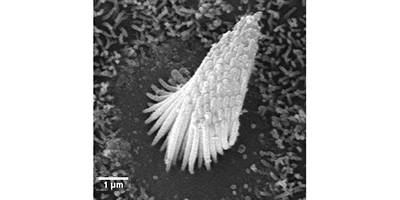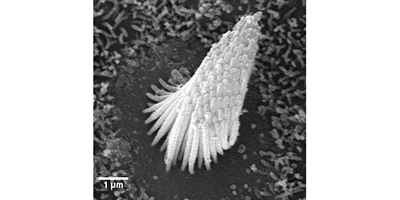The Hairs Rustling in Your Ears
The ear’s amazing sensitivity to faint sounds comes from cells with hairlike protrusions in the inner ear. The exact mechanism remains a mystery, but a recent experiment explores how spontaneous vibrations in these hair cells synchronize intermittently with weak mechanical signals. As described in Physical Review Letters, the observations suggest that hair cells may respond to sounds through changes in the timing (or phase) of their internally driven vibrations.
The inner ear contains thousands of hair cells, each with a “hair bundle” of – protrusions. Sound waves entering the ear can induce hair bundle vibrations, which are converted into electrical signals and sent to the brain. What remains unexplained is how the weakest audible sounds are detected, since they excite vibrations below the thermal noise background in the ear. The answer may be active amplification. Previous experiments performed in vitro found that bundles oscillate spontaneously from an internal driver, and this motion could synchronize with a small external input.
Yuttana Roongthumskul and colleagues from the University of California, Los Angeles, have performed new in vitro experiments on individual hair bundles from a bullfrog auditory system. Unlike previous observations that focused on the amplitude response, the team recorded the phase of spontaneous oscillations as the bundles were stimulated with a vibrating glass fiber. High-speed camera data showed the degree to which the bundles synchronized with the stimulating signal. For relatively strong stimulations, fiber and bundle motions had a constant phase difference (i.e., they were “phase-locked”). But for weaker stimulations, the hair bundles exhibited “phase slips” as they temporarily lost synchronization and then regained it. The authors believe this intermittent synchronization, occurring in an ensemble of cells, provides a possible model for sensitivity at the lower limit of audibility. – Michael Schirber





